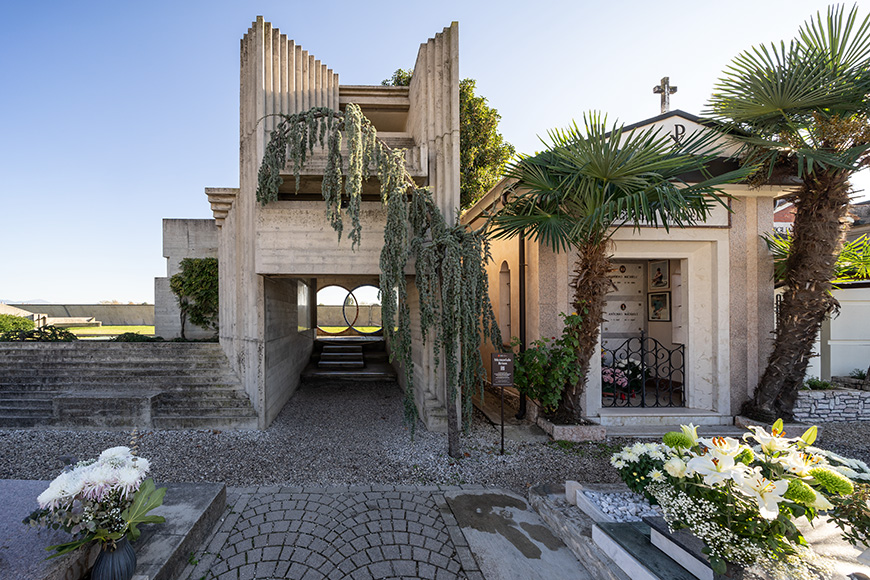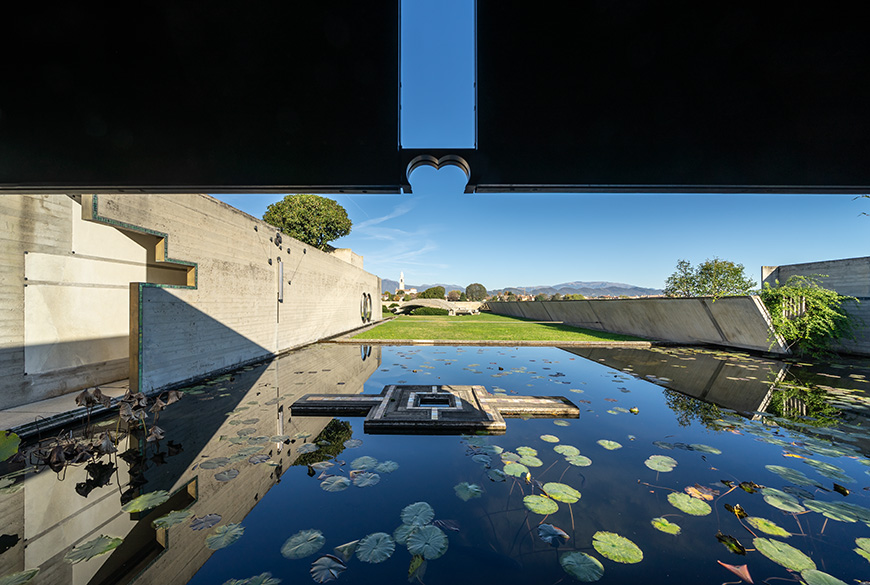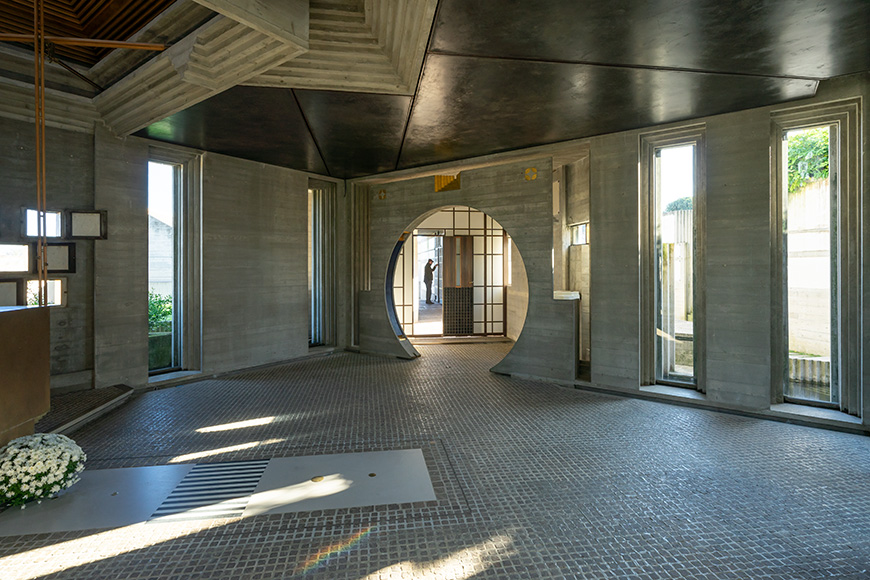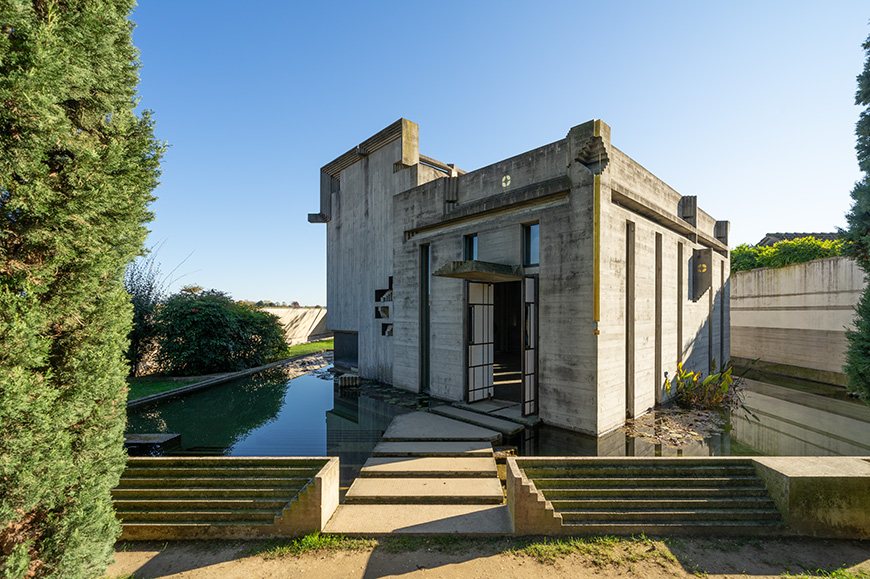Brion Tomb, Carlo Scarpa’s Last Masterpiece
The entrance of the Brion Tomb in the small graveyard of San Vito; photo © Riccardo Bianchini/Inexhibit
The Brion Tomb, Carlo Scarpa’s Last Masterpiece
If you don’t search for it, you will unlikely find the Brion Tomb by accident.
The last architectural work by Carlo Scarpa, and one of the Venetian master’s greatest masterpieces, the memorial is located inside a small cemetery in the Treviso province countryside; to get there you have to drive along the road connecting Castelfranco Veneto to Asolo and then detour along a narrow cypress-lined country road to the cemetery in San Vito d’Altivole. Welcomed by a very friendly staff, we visit the memorial on a sunny late November day with about 20 people, mostly Asians and Scandinavians.
A bit of history
The design of the Brion Tomb, known as Memoriale Brion in Italian, was commissioned to Scarpa in 1969 by Onorina “Rina” Brion Tomasin, widow of Giuseppe Brion, founder of Brionvega, a consumer electronics company that in the postwar period also became famous for its collaboration with great designers including Achille and Piergiacomo Castiglioni, Mario Bellini, Richard Sapper, and Marco Zanuso.
Scarpa deeply committed himself to the project, to which he devoted nine years of his life; however, he would not see it completed: in fact, he died in 1978 during a trip to Japan following a trivial fall, the work would be finished by his son, Tobia
Initially, the Brion family planned to have a modestly sized work built; they purchased a small plot of land of a few dozen square meters in the San Vito cemetery with the idea of building a family chapel, but for various reasons the project area would eventually grow to occupy a lot of 2,200 square meters. In this area, Scarpa designed an architectural complex, comprising five pavilions set in a large garden, into which he poured many of the inspirations and suggestions he had accrued throughout his life.
Completed in 1978, the Memoriale was immediately recognized as one of the masterpieces of postwar Italian architecture. Restored in 2018 to a design by Guido Pieropoli, who had been Scarpa’s collaborator, four years later it was donated by the Brion family to FAI – Fondo per l’Ambiente Italiano, which took over its management.
Curiosities related to the memorial include the film Dune: Part Two, by Denis Villeneuve, in which the memorial “plays” the role of the Emperor’s mansion. The Brion Tomb is normally open to the public, it is advisable to contact FAI to check the opening hours, which vary depending on the time of year; the unguided tour is free, however, a small contribution is due to participate in the maintenance of the monument’s facilities and green areas.
The Brion Memorial
It is not difficult to identify the Brion Memorial within the small cemetery of San Vito, where it stands out for its modern style, and yet Scarpa’s architecture appears perfectly integrated into the context of the country cemetery, not imposing itself but fitting into it naturally.
The first building one encounters upon entering the memorial, the Entrance pavilion also known as Propilei, immediately shows many of the stylistic elements of the complex: the primal geometric forms, the cuts that open up views of the inner garden and the Treviso countryside, the ubiquitous presence of water, the base concrete surfaces in which white Venetian stucco parts, marble slabs, Murano glass tiles, wooden inserts, and metal elements in iron, brass, and bronze are inserted.
The famous double-ring window in the entrance pavilion is a reference to the bond of love between Rina and Giuseppe Brion; photo © Riccardo Bianchini/Inexhibit
Architectural details of the Brion Tomb feature an impressive variety of materials and techniques; photo © Riccardo Bianchini/Inexhibit
Turning to the right of the entrance pavilion, a narrow concrete corridor with a ceiling decorated with small ebony tiles leads to another building, the Meditation Pavilion, whose roof of metal, larch wood, and marine plywood seems to levitate suspended on three slender steel columns. From the pavilion, the gaze glides over a body of water populated with water lilies, past a meadow to rest on an arched structure: it is the so-called Arcosolio, where the tombs of Giuseppe and Rina Brion gaze at each other under a “sky” made of green and blue glass tiles on a gold leaf layer. Behind the Arcosolium is another small concrete pavilion, intended for the graves of family members.
The Meditation Pavilion is a Japanese-inspired building surrounded by water; photo © Riccardo Bianchini/Inexhibit
The Meditation Pavilion with the water mirror in the foreground and the so-called Arcosolio in the distance; photo © Riccardo Bianchini/Inexhibit
Another view of the Arcosolio funerary pavilion; photo © Riccardo Bianchini/Inexhibit
The sarcophagus of Onorina Brion Tomasin in the Arcosolio; photo © Riccardo Bianchini/Inexhibit
The last building in the complex is the Chapel, or Tempietto, located at the northwestern end of the site. In its forepart, Scarpa cites elements of the Japanese architecture he loved so much; behind the forepart is the chapel proper, in which we find elements already heralded in the entrance pavilion, such as the large concrete “oculus” that marks the entrance to the ceremonial space and the stepped modeling of the concrete walls. The interior space is bathed in warm light that filters through a series of narrow vertical openings, creating an atmosphere of timeless calm. Behind the chapel, a small pool of water and a row of cypress trees mark the western boundary of the Tomb.
The forepart of the Chapel incorporates various elements inspired by Japanese architecture; photo © Riccardo Bianchini/Inexhibit
Interior views of the Chapel; photos © Riccardo Bianchini/Inexhibit
The Chapel from the outside; photo © Riccardo Bianchini/Inexhibit
A true summa of Scarpa’s poetics, the Brion Tomb includes many references – to oriental architecture, Byzantine and Islamic in the first place, but also to the artisan and architectural culture of his city, Venice – which the master reworks and recombines using them for the construction of his own language. In the case of the Memoriale, Scarpa “invents” a place where the planes of reading seem infinite, a space in which every element, every form, every detail reveals new aspects, concealed beneath the apparent ones, just by pausing to look at them carefully. At the same time, it is a space where architecture is inextricably linked to the spirit of the place, at the same time generating it and being a consequence of it.
In fact, the Brion Memorial appears to be anything but a space of death; instead, it is a place that invites contemplation of life, love for loved ones, meditation, and transcendence. After all, it is not surprising that Scarpa chose to be buried here.
The tomb of Carlo Scarpa is placed in a private corner of the Brion Tomb complex; photo © Riccardo Bianchini/Inexhibit
Memoriale Brion
Via Brioni, Altivole (Treviso), Italy
Official website: https://fondoambiente.it/luoghi/memoriale-brion/
Telephone: +39 349 8781601
E-mail: memorialebrion@fondoambiente.it
copyright Inexhibit 2025 - ISSN: 2283-5474


















